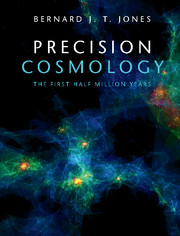Book contents
- Frontmatter
- Dedication
- Contents
- Preface
- Notation and Conventions
- Part I 100 Years of Cosmology
- Part II Newtonian Cosmology
- Part III Relativistic Cosmology
- Part IV The Physics of Matter and Radiation
- 19 Physics of the CMB Radiation
- 20 Recombination of the Primeval Plasma
- 21 CMB Polarisation
- 22 CMB Anisotropy
- Part V Precision Tools for Precision Cosmology
- Appendix A SI, CGS and Planck Units
- Appendix B Magnitudes and Distances
- Appendix C Representing Vectors and Tensors
- Appendix D The Electromagnetic Field
- Appendix E Statistical Distributions
- Appendix F Functions on a Sphere
- Appendix G Acknowledgements
- References
- Index
19 - Physics of the CMB Radiation
from Part IV - The Physics of Matter and Radiation
Published online by Cambridge University Press: 04 May 2017
- Frontmatter
- Dedication
- Contents
- Preface
- Notation and Conventions
- Part I 100 Years of Cosmology
- Part II Newtonian Cosmology
- Part III Relativistic Cosmology
- Part IV The Physics of Matter and Radiation
- 19 Physics of the CMB Radiation
- 20 Recombination of the Primeval Plasma
- 21 CMB Polarisation
- 22 CMB Anisotropy
- Part V Precision Tools for Precision Cosmology
- Appendix A SI, CGS and Planck Units
- Appendix B Magnitudes and Distances
- Appendix C Representing Vectors and Tensors
- Appendix D The Electromagnetic Field
- Appendix E Statistical Distributions
- Appendix F Functions on a Sphere
- Appendix G Acknowledgements
- References
- Index
Summary
The Cosmic Microwave Background Radiation not only provided the key evidence for what has become our basic view of the Universe, but it has also provided a powerful tool with which to study the Big Bang itself. The radiation we see comes from a red-shift of around 1000 and is the result of some complex physical processes that take place in the preceding ‘fireball' phase of the cosmic expansion. The tools for studying the early Universe come from an understanding of those physical processes. The goal of this chapter is to explain the physics of the fireball from the point of view of the radiation field, and to present the means by which we analyse the measurements to extract information about the Universe.
These measurements are now being made with extraordinary accuracy over a wide range of angular scales and frequencies. It is that accuracy that allows us to use the CMB as a probe of the physics of the fireball and to determine the values of cosmological parameters with a precision of a mere few percent. In this chapter we present the theory of the radiation field, what we expect from our observations and how we interpret what is seen.
The Radiation Field
The cosmic fireball is a somewhat unusual environment, far from any laboratory experience. The principal difference lies in the intensity of the cosmic radiation field: in the Universe photons outnumber baryons by some eight orders of magnitude.
Some of the material in this chapter is based on the seminal paper of Sunyaev and Zel'dovich (1970). This is one of the most important papers written on the subject of the CMB.
The Equilibrium Distribution of Photons
The radiation field can be most simply defined by telling how many photons there are of a given frequency moving in a particular direction. However, things are complicated somewhat because the radiation field is measured in terms of the flux of energy carried across a unit surface by photons of a given frequency moving into a given solid angle about a direction normal to the surface. For radiation in thermodynamic equilibrium at some temperature, this flux follows the famous Planck law. In this section we discuss the concept of flux and then relate it to the equilibrium distribution function for the photons and so derive the Planck law from basic principles.
- Type
- Chapter
- Information
- Precision CosmologyThe First Half Million Years, pp. 451 - 475Publisher: Cambridge University PressPrint publication year: 2017



